Modeling individual differences in the timing of change onset and offset
- PMID: 34570554
- PMCID: PMC8957627
- DOI: 10.1037/met0000407
Modeling individual differences in the timing of change onset and offset
Abstract
Individual differences in the timing of developmental processes are often of interest in longitudinal studies, yet common statistical approaches to modeling change cannot directly estimate the timing of when change occurs. The time-to-criterion framework was recently developed to incorporate the timing of a prespecified criterion value; however, this framework has difficulty accommodating contexts where the criterion value differs across people or when the criterion value is not known a priori, such as when the interest is in individual differences in when change starts or stops. This article combines aspects of reparameterized quadratic models and multiphase models to provide information on the timing of change. We first consider the more common situation of modeling decelerating change to an offset point, defined as the point in time at which change ceases. For increasing trajectories, the offset occurs when the criterion attains its maximum ("inverted J-shaped" trajectories). For decreasing trajectories, offset instead occurs at the minimum. Our model allows for individual differences in both the timing of offset and ultimate level of the outcome. The same model, reparameterized slightly, captures accelerating change from a point of onset ("J-shaped" trajectories). We then extend the framework to accommodate "S-shaped" curves where both the onset and offset of change are within the observation window. We provide demonstrations that span neuroscience, educational psychology, developmental psychology, and cognitive science, illustrating the applicability of the modeling framework to a variety of research questions about individual differences in the timing of change. (PsycInfo Database Record (c) 2023 APA, all rights reserved).
Figures



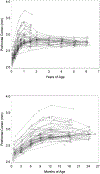
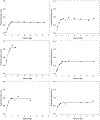
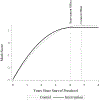

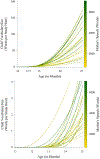
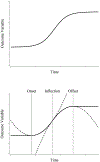

References
-
- Ahmed W, van der Werf G, Kuyper H, & Minnaert A (2013). Emotions, self-regulated learning, and achievement in mathematics: A growth curve analysis. Journal of Educational Psychology, 105, 150–161. 10.1037/a0030160 - DOI
-
- Bauer DJ, Goldfield BA, & Reznick JS (2002). Alternative approaches to analyzing individual differences in the rate of early vocabulary development. Applied Psycholinguistics, 23, 313–335. DOI 10.1017.S014271640200301
-
- Becker M, & Neumann M (2018). Longitudinal big-fish-little-pond effects on academic self-concept development during the transition from elementary to secondary schooling. Journal of Educational Psychology, 110, 882–897. 10.1037/edu0000233 - DOI
-
- Berkhof J, & Snijders TA (2001). Variance component testing in multilevel models. Journal of Educational and Behavioral Statistics, 26(2), 133–152.

